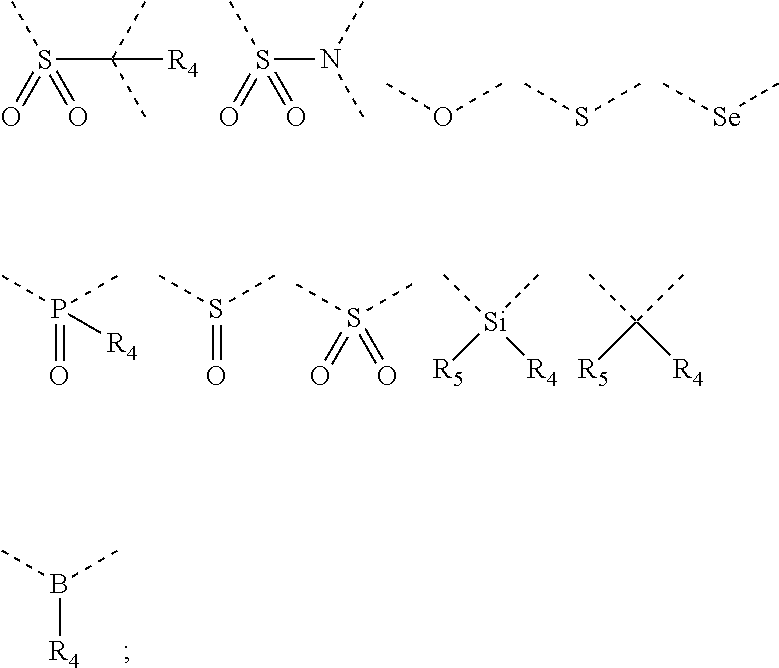Silicon-containing organic compound and applications thereof
a technology of organic compound and silicon, applied in the field of organic electroluminescent materials, can solve the problems of reducing the efficiency of the oled rapidly with an increase in current or luminance, limiting the internal electroluminescence quantum efficiency to 25% under electrical excitation, and complexes including iridium or platinum, which are rare and expensive, and achieves low cost, improve the luminescent efficiency and lifetime of the electroluminescent device, and facilitate the realization of luminescent properties.
- Summary
- Abstract
- Description
- Claims
- Application Information
AI Technical Summary
Benefits of technology
Problems solved by technology
Method used
Image
Examples
example 1
3′,7′-bis(di-p-toluidine)-3,7-dinitrile-5,5′-spiro[diphenyl[b,d]silylfluorene]
[0156]
[0157]5.4 g, 10 mmol of 3,7-dibromo-3′,7′-dinitrile-5,5′-spirodisilylfluorene, 4.4 g, 22 mmol of 4,4′-dimethyldiphenylamine, 4.8 g, 50 mmol of sodium tert-butoxide, 0.45 g, 2 mmol of Pd(OAc)2, and 150 ml of toluene were added into a 250 ml of three-necked flask, and were reacted in an atmosphere of N2 at a temperature of 110° C. The reaction progress was tracked by TLC. After the reaction was completed, the reaction solution was cooled to room temperature. The reaction solution was poured into water, washed to remove the sodium tert-butoxide, and then was suction-filtered to obtain a solid product. The solid product was dissolved with dichloromethane to remove impurities therein. The recrystallization was performed by using ethanol, thereby obtaining 6.2 g of 3′,7′-bis(di-p-toluidine)-3,7-dinitrile-5,5′-spiro[diphenyl[b,d]silylfluorene] as a solid powder. MS(ASAP)=773.4.
example 2
5′-phenyl-5′H, 1 OH-spiro[diphenyl[b,e]aminosilyl-5,10′-diphenyl[b,e][1,4]-10-ketodiphenylsilane]
[0158]
[0159]150 ml of dry THF, 4.0 g, 10.0 mmol of 2,2′-dibromotriphenylamine were added into a 250 ml of three-necked flask, and cooled to a temperature of −78° C. until completely dissolved. 20.0 mmol of n-butyllithium solution was slowly dropwise added to the mixed solution, and the reaction was continued for 2 hours. The resulting solution was dropwise added to a THF solution of 2.8 g, 10 mmol of 5,5-dichloro-10-ketobiphenyl[b,e]silane at a temperature of −78° C. The reaction was continued at a low temperature overnight and the reaction progress was tracked by TLC. After the reaction was completed, the reaction solution was spontaneously warmed up to room temperature. The reaction solution was poured into water and extracted with dichloromethane. The organic phases were combined, dried, and suction-filtered, and then evaporated to dryness, thereby obtaining a crude product. The recry...
example 3
3,7-bis(4,6-diphenyl-1,3,5-triazine)-5′-phenyl-5′H-spiro[diphenyl[b,d]silyl-5,10′-diphenyl[b,e][1,4]aminosilicon]
[0160]
[0161]5.1 g, 10.0 mmol of 5′-phenyl-3,7-diboric acid-5′H-spiro[diphenyl[b,d]silyl-5,10′-diphenyl[b,e][1,4]diphenylamino silicon], 5.84 g, 22.0 mmol of 2-chloro-4,6-diphenyl-1,3,5-triazine, 6.9 g, 50 mmol of potassium carbonate, 1.15 g, 1 mmol of Pd(PPh3)4, 100 ml of toluene, 25 ml of water, and 25 ml of methanol were added into a 250 ml of three-necked flask, and were reacted in an atmosphere of N2 at a temperature of 110° C. The reaction progress was tracked by TLC. After the reaction was completed, the reaction solution was cooled to room temperature. The reaction solution was poured into water, washed to remove the potassium carbonate, and then was suction-filtered to obtain a solid product. The solid product was washed with dichloromethane. The recrystallization was performed by using toluene / petroleum ether mixed solvent, thereby obtaining 7.0 g of 3,7-bis(4,6-...
PUM
| Property | Measurement | Unit |
|---|---|---|
| electroluminescence quantum efficiency | aaaaa | aaaaa |
| electroluminescent quantum efficiency | aaaaa | aaaaa |
| triplet energy level T1 | aaaaa | aaaaa |
Abstract
Description
Claims
Application Information
 Login to View More
Login to View More - R&D
- Intellectual Property
- Life Sciences
- Materials
- Tech Scout
- Unparalleled Data Quality
- Higher Quality Content
- 60% Fewer Hallucinations
Browse by: Latest US Patents, China's latest patents, Technical Efficacy Thesaurus, Application Domain, Technology Topic, Popular Technical Reports.
© 2025 PatSnap. All rights reserved.Legal|Privacy policy|Modern Slavery Act Transparency Statement|Sitemap|About US| Contact US: help@patsnap.com



